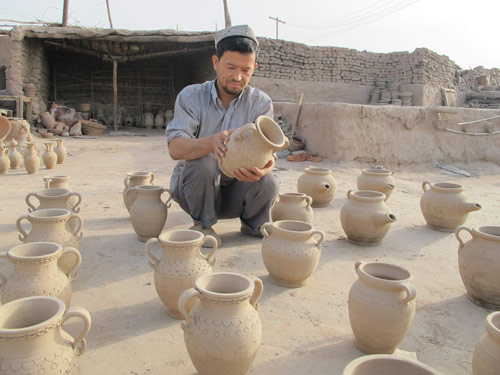
 |
|
Omar Ali dries his pots in the sun. |
Starting at 17, Rustam is the sixth-generation inheritor of Kashi pottery in his family. He says before the 1960s, pottery wares dominated the daily lives of Uygurs, be it in the field of agriculture or architecture.
"There were 120 households of more than 300 pottery makers then at Tower Houses," says Uygur folk culture expert Ali Obulkasim.
But the number has shrunk to 13 households of 26 makers today within the entire Kashi area, the 65-year-old adds. Only nine households are sticking to their old workshops at Tower Houses.
Omar Ali, 41, is the youngest among the Kashi pottery makers. He learned the craft from his father since the age of 15 after he graduated from junior high school.
Explaining the procedure, Ali says the entire process for a kiln of pottery is 15 days.
First, the loess is soaked in water for two days and stirred into clay. Form the clay into various shapes on the spinning tray before drying in the sun. Imprint the clay with patterns and glaze before putting them into a burner for seven hours.
"Unlike porcelain wares that need to be burned several times, we only burn once for Kashi pottery," Ali says, adding that the kiln's temperature is never measured but is based on the observation of the flame.
The finished products are grazed in yellow, green, red or black, depending on the kinds of mineral powder added in. The copper powder, for example, gives the green; the iron powder makes the red, he explains.
"As technology develops, pottery wares are less and less used in daily life; they exist more as handicraft works today," says Obulkasim, the Uygur folk culture expert.
Catering to the tourists' need, pottery makers like Rustam and Ali are capable of creating up to 300 different kinds of wares.
But a few years ago, the local government began to bar tourists from Tower Houses as many cottages are in dire need of repair and may be a threat to the tourists' safety.
The pottery business has since dropped sharply. Now, makers no longer create new shapes but stick to regular ones such as flowerpots and water vats, which are sold in the neighborhood.
Winter is the most challenging season for these heritage guardians. When the weather turns cold, the low temperature freezes the clay, making the procedure extremely difficult. Ali suffers from arthritis because of working in cold weather, but says he has to hold on "to make a living".
Despite the sacrifices, he only earns about 1,000 yuan per month to support a family of six.
To guarantee the sales volume, these pottery makers sell their products to Taxpolat Eziz, a wholesaler at Kashi Guza Taxtak Market outside the Tower Houses.
Eziz gave up his family tradition of pottery making to become a wholesaler so that he can earn more. He is among six pottery wholesalers in Kashi.

Apart from low income, pottery makers also face bad working conditions and the challenge of inheritance. "I need larger room to place and dry those clay items," says Rustam, adding that his age makes it harder to climb the bamboo ladders to his workshop.
"Young people are not willing to learn the skills in such an environment," he says. Although reluctant, Rustam is ready to move out of Tower Houses in search of a bigger space.
His colleague Ali is not as willing. "Once we leave, Kashi pottery loses its cultural context," he stresses.
As one of the four city-level intangible cultural heritage successors, Ali is applying for the autonomous region-level title. Meanwhile, Rustam is applying for the State-level intangible cultural heritage successor. If he succeeds, he will be the first and the only State-level Kashi pottery inheritor in China.
Rustam's only disciple is his 24-year-old son, who has been learning pottery making for three years.
"It's very likely that one day Kashi pottery will disappear. But as long as we have inheritors, we still have some hope," Rustam says.
Contact the writer at zhangzixuan@chinadaily.com.cn.